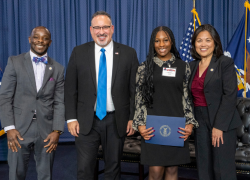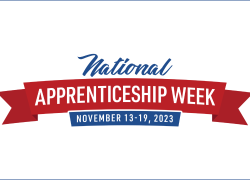
Good jobs bring workers into the labor market and companies are realizing that providing good quality jobs make them an employer of choice, maintaining a competitive advantage in recruitment, retention, and the execution of their company’s mission. In today’s labor market where employers are working hard to attract and retain new talent and engage nontraditional populations such as the youth and re-entry population, good jobs are essential.
Our workforce system can be a valuable partner in developing good jobs – and our new guidance and Job Quality Academy can help them do so and build on evidence-based workforce strategies that close equity gaps, such as career pathways, registered apprenticeships and sector strategies.
Defining Job Quality
A good job is one that helps workers achieve economic stability and upward mobility, while also prioritizing diversity and worker voice. The U.S. Departments of Labor and Commerce partnered to identify the Good Jobs Principles and these eight principles provide a framework for businesses, workers, labor unions, advocates, researchers, state and local governments and federal agencies for a shared vision of job quality. Together, we can build on evidence-based workforce strategies, including career pathways, Registered Apprenticeship programs and sector strategies to empower employers to scale good jobs, connect individuals to those good jobs and improve equity in access to good jobs.
Promoting Job Quality
To assist in applying the principles of a good job, the Labor Department recently released guidance to outline how the workforce system should integrate good job strategies into its employer partnerships and workforce training.
We’re also launching a Job Quality Academy, which will help the workforce system connect historically marginalized populations and communities that disproportionately face employment barriers with good jobs.
How It Works
Designed and operated with Jobs for the Future and other partners, the Job Quality Academy will enhance participants’ understanding of job quality principles, teach them how to incorporate those principles into their policies and programs and provide them with clear steps on how to implement the lessons to achieve the greatest impact.
Comprised of up to 16 teams representing communities across the nation, the academy will help participants take immediate action on the guidance provided in TEGL 07-22 and the Good Jobs Initiative.
Who Can Apply
All state and local workforce boards, state workforce agencies, and tribal organizations are eligible to apply as team leads. Teams must include a worker voice-focused organization such as a worker center or union representative, and can also include any community-based organization, employer or employer representative, or any other organization committed to improving job quality in your community.
To learn more and apply, go to Job Quality Academy and attend our webinar on the application process. Applications are due by Tuesday, March 14.
Brent Parton is the acting secretary of employment and training.
Editor's Note: This blog was updated to include an expanded introduction providing more context about the new programs.

 U.S. Department of Labor Blog
U.S. Department of Labor Blog




